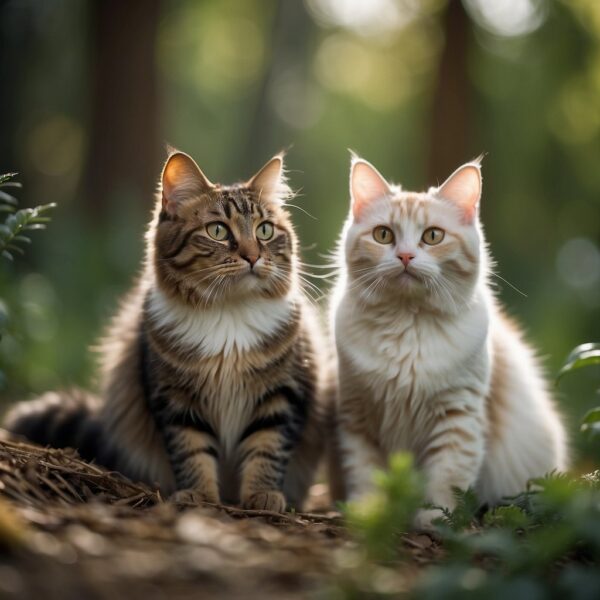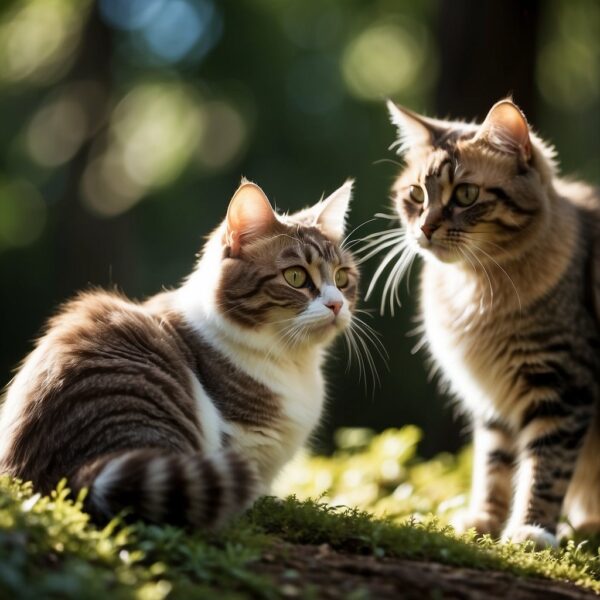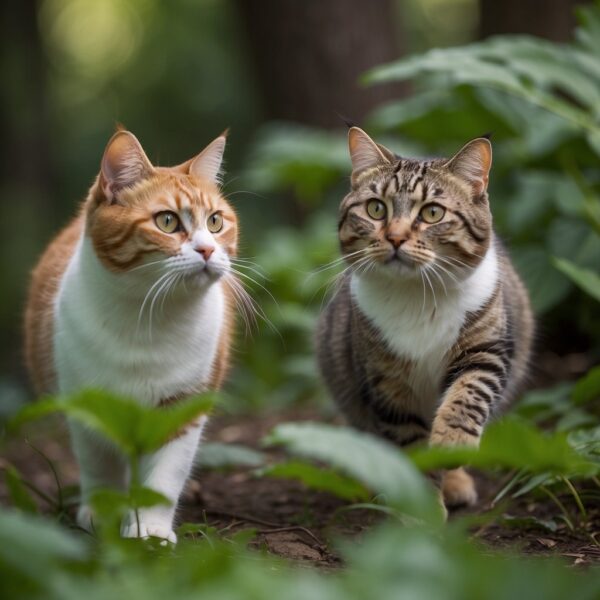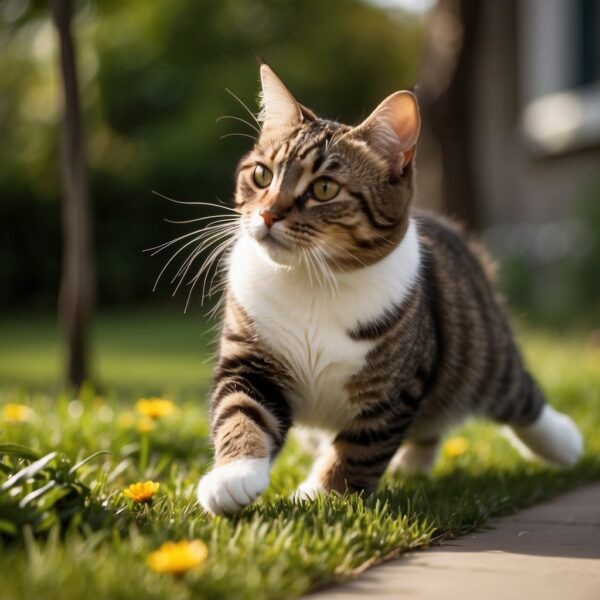
Kurilian Bobtail Cats: Kuril Island cats
The Kurilian Bobtail cat boasts a distinctive bobbed tail, each as unique as a fingerprint, which is a defining feature of this natural breed. Originating from the Russian Far East, specifically the Kuril Islands, this feline possesses a combination of intriguing history and charming physical attributes. Despite its somewhat wild appearance and remarkable hunting abilities, the Kurilian Bobtail is known for its gentle and friendly demeanor, making it a suitable companion for families and singles alike.
In terms of physicality, the Kurilian Bobtail is a robust and muscular cat that often exhibits the coveted “wild look” with a substantial body and a plush, fluffy tail that is notably different on each individual cat. Their dynamic personalities are complemented by their intelligence and active nature, requiring an environment that stimulates their playful and curious spirits. Recognized for their adaptability, Kurilian Bobtails can thrive both indoors and outdoors, provided that their mental and physical stimulation needs are met.
Key Takeaways
- Kurilian Bobtails possess unique bobbed tails and a physicality that mirrors their wild origins.
- This breed balances its active and playful personality with a gentle, sociable nature.
- They are adaptable to various living environments and require engagement and care.
Kurilian Bobtail Cat Origin and History
The Kurilian Bobtail cat boasts a fascinating line of descent that intertwines the genetics of the Japanese Bobtail with Siberian cats. This amalgamation is believed to have been inadvertently crafted by sailors who introduced Siberian cats to the Kuril Islands. Over time, this fusion gave rise to a breed with distinct characteristics suited to the islands’ landscapes.
It is a breed with a storied past, one that resonates through centuries of existence on the Kuril Islands, a collection of volcanic islets shared between Russia and Japan. Notably, the breed is named after this distinct geographic feature. The cats are not just prominent figures in the households they grace but are also woven into the tapestry of Russian and Japanese folklore.
Characteristics of the Kurilian Bobtail include:
- Physical Traits: The Kurilian Bobtail typically presents a robust, wild exterior, characterized by its muscular build and unique pom-pom-like tail. With two coat variations, short and long hair, they exhibit a semi-cobby body type.
- Temperament: Intelligence is a hallmark of this breed, coupled with a disposition that is amenable to training. Their gentle nature makes them suitable companions for families, including those with children.
By 1994, the World Cat Federation (WCF) recognized the Kurilian Bobtail, sealing its status as a pedigree breed. The intersection of its natural predatory skills as a hunter and fisher on the said islands and its domesticated demeanor reflects the breed’s duality — an adept survivor in the wild and a loving pet at home.

kurilian bobtail Physical Characteristics
The Kurilian Bobtail stands out for its particular robust and unique body structure, including a short, pom-pom-like tail, dense fur, and a muscular physique.
Size and Proportions
The Kurilian Bobtail generally exhibits a semi-cobby body type which means it has a medium to large frame with noticeable muscles and a broad chest. Typically, adult cats weigh between 8 and 15 pounds. They have a moderate size with a height ranging from 10 to 14 inches.
kurilian bobtail cat Coat and Color
The breed’s coat comes in two variations: short and semi-long. It is dense and may be presented in a variety of colors and patterns including:
- Solid
- Bicolor
- Tabby
- Calico
- Tortoiseshell
Coat colors span across brown, orange, gray, cream, black, and white. Eye colors can vary, complementing the coat with gold, green, blue, or even odd-eyed (heterochromia).
Tail Structure
The defining characteristic of the Kurilian Bobtail is its tail. Unlike typical cats, their tails are naturally short, kinked, and flexible, resembling a pom-pom. Each individual’s tail is unique, with a varied number of kinks, and can be up to 3 inches in length but often hidden within the fur.
kurilian bobtail cats Temperament and Behavior
The Kurilian Bobtail cat exhibits a unique combination of playful and affectionate behavior with high energy levels, balanced with sociability and moderate vocalization.
Social Behavior
The Kurilian Bobtail is known for its friendly and affectionate nature, often forging strong bonds with their human companions. They thrive in the company of their family members and are known to be good with children and other pets. This breed’s sociable disposition makes it a pleasant companion, eager to interact and be involved in family activities.
Activity Level
This breed displays a significant degree of energy and playfulness. Kurilian Bobtails are typically active, enjoying games that challenge their intelligence and physical abilities. They have a propensity for jumping and climbing, which means they enjoy perches and cat trees where they can survey their domain. Despite their playful nature, they can also have calm moments and do not require constant attention.
Vocalization
Kurilian Bobtails are moderately vocal. They tend to express themselves with soft chirps and trills rather than loud meows, often to initiate play or indicate a need for interaction. Their vocalizations are typically seen as endearing and are a way for them to communicate with their owners, but are not known to be a disruptive or excessively loud breed.

Health and Lifespan
The Kurilian Bobtail is generally healthy with a long life expectancy but, like all cat breeds, they can have breed-specific health issues. Regular care and maintenance are crucial for their well-being.
Common Health Issues
Kurilian Bobtails may be predisposed to certain genetic conditions, although no widespread health problems are specifically associated with the breed. Parents should be vigilant for signs of common feline ailments:
- Dental issues such as gingivitis
- Heart conditions like hypertrophic cardiomyopathy
- Kidney diseases, including polycystic kidney disease
Care and Maintenance
Proper care is key to preventing health issues in Kurilian Bobtails:
- Diet: A balanced diet appropriate to the cat’s age, size, and activity level
- Exercise: Regular play sessions to maintain good physical condition
- Grooming: Weekly brushing for short-haired, more often for long-haired to prevent tangles and matting
- Veterinary Care: Routine check-ups, vaccinations, and prompt attention to signs of illness
Life Expectancy
The life expectancy of a Kurilian Bobtail is relatively long, typically ranging from 15 to 20 years. Factors that influence lifespan include genetics, diet, activity level, and access to preventive health care. With proper attention to their health and well-being, these cats can be cherished companions for many years.
Breeding and Genetics
The Kurilian Bobtail is a breed with distinct genetic traits that contribute to its unique appearance and temperament. Breeders must adhere to certain standards to maintain the breed’s health and characteristics.
Genetic Diversity
The Kurilian Bobtail cat possesses a notable genetic trait in its short, pom-pom-like tail, originating from a natural genetic mutation. This breed is known for its robust genetic diversity, which is partly attributed to its natural development on the Russian islands of Sakhalin and Kuril. The genetic pool has remained relatively diverse, reducing the incidence of hereditary health problems common in other purebred cats.
Breeding Standards
Breeders of Kurilian Bobtails are expected to follow strict breeding standards to preserve the physical and temperamental traits of the breed.
Physical Standards:
- Body: Medium to large, semi-cobby with well-developed muscles
- Coat: Comes in short and semi-long lengths, displaying various colors and patterns including solid, bicolor, tabby, calico, and tortoiseshell
- Tail: Naturally short and fluffy, each tail unique to the individual cat
Temperament Standards:
- Breeders should aim to raise cats that exhibit the breed’s characteristic playful, energetic, and sociable nature.
Maintaining these standards ensures the breed’s signature look and behavior are consistently presented in every new generation.

Living Environment
Kurilian Bobtail cats thrive in environments that cater to their playful and active nature. They are adaptable and can live comfortably in apartments or houses, as long as they have enough space to exercise and explore.
Space and Exercise
These cats are energetic and require room to move around. Guardians should provide:
- Spacious areas free from breakable objects to prevent accidents during play.
- Cat trees and shelves for climbing to satisfy their natural inclinations and keep them fit.
- Scratching posts to maintain claw health and discourage unwanted scratching on furniture.
Safety Measures
To create a safe living environment:
- Keep small items that can be swallowed out of reach.
- Secure electrical cords to prevent chewing.
- Childproof locks on cabinets can prevent access to harmful substances.
Enrichment
Mental stimulation is crucial for the Kurilian Bobtail’s well-being. Consider providing:
- A variety of toys to keep them mentally stimulated.
- Regular interaction and playtime to strengthen their bond with family members.
- Access to windows for environmental enrichment and to observe the outdoors.
By addressing these aspects, an owner can ensure their Kurilian Bobtail enjoys a happy and enriching living environment.
Grooming Needs
Kurilian Bobtails are a unique breed with specific grooming requirements due to their distinctive coat. Their coat consists of a soft, downy undercoat topped by a water-repellent overcoat. Regular grooming is necessary to maintain their coat’s health and prevent issues like matting and tangling.
Brushing
One should brush a Kurilian Bobtail’s coat one to two times weekly. A slicker brush or grooming mitt is the tool of choice. Brushing should follow the direction of hair growth to efficiently remove dead hair and detangle. This also helps distribute natural skin oils, which keep their coat shiny and healthy.
Bathing
Bathing a Kurilian Bobtail is rarely necessary and is typically reserved for when the cat is significantly dirty or if there are skin issues. Due to the coat’s water-repellent properties, baths should be infrequent to preserve the coat’s natural condition.
Nail Clipping
Routine nail clipping is a part of grooming to prevent potential scratches or injuries. Clipping every few weeks is generally sufficient.
Dental Care
Tooth brushing also falls within the Kurilian Bobtail’s grooming regimen. Regular dental care helps prevent periodontal diseases and contributes to overall health.
| Activity | Frequency | Tools & Tips |
|---|---|---|
| Brushing | Weekly | Use a slicker brush or grooming mitt |
| Bathing | As needed | Only when especially dirty or for skin issues |
| Nail Clipping | Every few weeks | Monitor nails and clip to prevent injury |
| Tooth Brushing | Regularly | Use a vet-approved toothpaste and toothbrush for cats |
A consistent grooming routine supports the well-being and aesthetic appeal of these captivating cats and fosters a strong bond between the Kurilian Bobtail and their guardians.
Adoption and Buying Guidelines
When considering the addition of a Kurilian Bobtail to one’s family, they may choose to adopt or purchase this distinctive breed. Adoption should be the first consideration. Prospective parents can reach out to local animal rescue groups or shelters, where they might find Kurilian Bobtails in need of a loving home.
For those seeking to purchase a Kurilian Bobtail, it’s critical to find a reputable breeder. Breeders should provide health clearances and allow potential buyers to visit and observe the cats’ living conditions. A responsible breeder focuses on the cats’ well-being and genetic health, often being affiliated with breed clubs or federations such as WCF (World Cat Federation).
Key Considerations for Adoption or Buying:
- Health: Confirm the cat has been health-checked and has vaccination records.
- Environment: Ensure the cat has been raised in a clean, healthy environment.
- Socialization: Check that the cat has been properly socialized with humans and other animals.
- Documentation: Request pedigree papers from breeders to prove the cat’s lineage.
Useful checklist for potential cat parents:
- Research the breed and its characteristics
- Contact local shelters, rescue groups, or breed clubs
- Visit the cat in its environment
- Ask for health and vaccination records
- Verify breeder’s credentials (if purchasing)
By following these guidelines, individuals can ensure they responsibly bring a Kurilian Bobtail into their home, whether through adoption or purchase.

Frequently Asked Questions
The Kurilian Bobtail cat draws interest due to its unique appearance and sociable nature. This section addresses common inquiries potential parents might have.
How much does a Kurilian Bobtail cat typically cost?
Prices for a Kurilian Bobtail cat can vary widely but typically range from $700 to $3,000. Costs may fluctuate based on the breeder’s reputation, the location, and the cat’s pedigree.
What are the personality traits of Kurilian Bobtail cats?
They are affectionate, playful, and known for their friendly and social nature. Kurilian Bobtails possess an adaptable personality, making them well-suited for family environments.
What should one consider when looking for a Kurilian Bobtail breeder?
Prospective buyers should seek reputable breeders who offer health clearances and who socialize their kittens early. It’s important to ensure that the breeder follows ethical breeding practices.
Is there a difference between Kurilian Bobtails and Japanese Bobtails?
Yes, Kurilian Bobtails and Japanese Bobtails are two distinct breeds. While they both have short tails, they differ in origin, physical characteristics, and breeding history.
Are Kurilian Bobtails considered hypoallergenic?
No cat is completely hypoallergenic, but Kurilian Bobtails are sometimes favored by allergy sufferers due to their coat type. However, individual reactions to cat dander vary greatly.
What are the adoption options for Kurilian Bobtail cats?
One can adopt Kurilian Bobtail cats from breeders, but it’s also worth checking with rescue organizations and shelters, where they may occasionally be available for adoption.